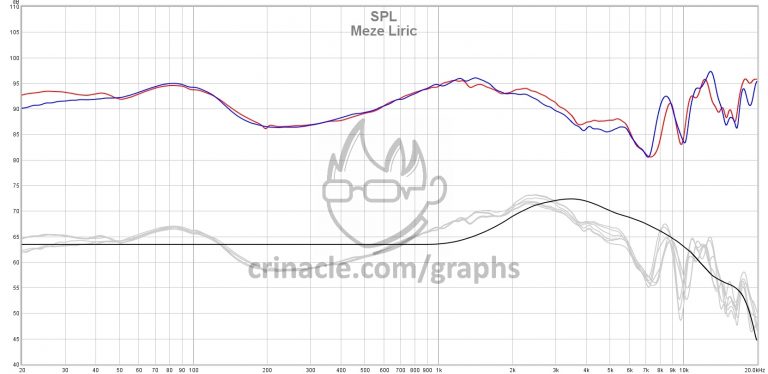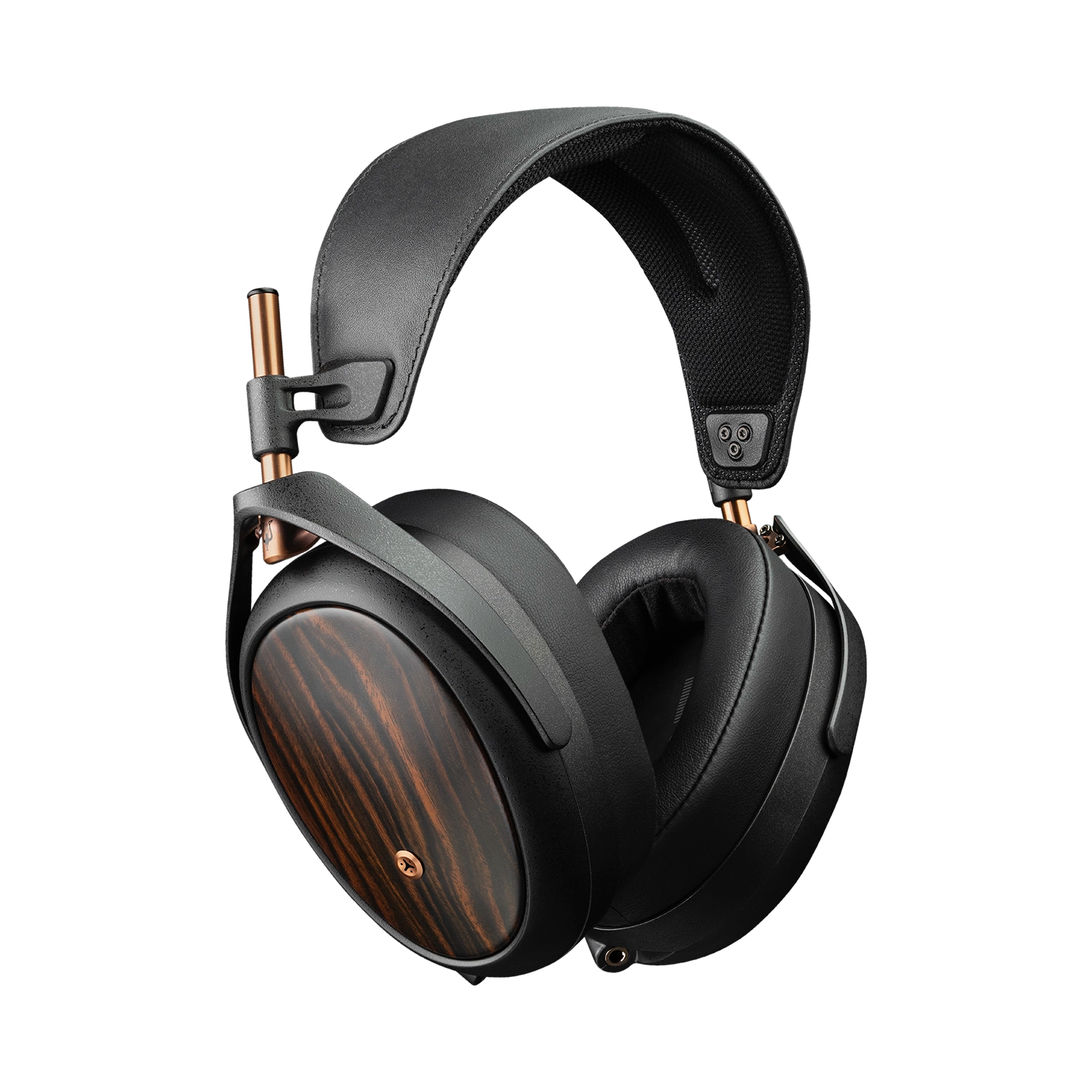This is a review and detailed measurements of the Meze Liric Hybrid Planar Magnetic Closed Back Headphone. It was kindly purchased new by a member and drop shipped to me:

The Liric costs US $2,000. The look is very understated but feels luxurious. The weight is about average for class at 360 grams:

The cups are not huge but fit my ears well at 69 by 39 mm. Depth is good at 23 mm. After wearing them for five minutes I forgot they were on my head so very good on that front.
Note: The measurements you are about to see are made using a standardized Gras 45C. Headphone measurements by definition are approximate and variable so don't be surprised if other measurements even if performed with the same fixtures as mine, differ in end results. Protocols vary such as headband pressure and averaging (which I don't do). As you will see, I confirm the approximate accuracy of the measurements using Equalization and listening tests. Ultimately headphone measurements are less exact than speakers mostly in bass and above a few kilohertz so keep that in mind as you read these tests. If you think you have an exact idea of a headphone performance, you are likely wrong!
The cups fit my fixture's artificial ears easily.
Meze Liric Pro Measurements
Let's start with our usual frequency response measurements:

I was (pleasantly) surprised to see so much bass response. Most headphones underperform our target in that region but here, we have some extra energy to play with. Not so good is too much energy around 1 kHz which will become a theme in this review. We then have some shortfall between 1.8 to 5 kHz which usually means degraded spatial qualities. After that, accuracy of measurements go down but there can be some excess treble energy above 7 kHz.
Subtracting the response from our target gives us the relative deviation from our target for development of equalization filters:

At 94 dBSPL distortion is exceedingly small matching company's claims (generally) in this regard:

But we have two narrow spikes which usually indicate resonances. One is near 1 kHz again. Here is the same but in absolute dB scale:

Group delay shows disturbance at the low frequency tuning of the driver:

Impedance is highly variable and once again shows a resonance around 1.8 kHz:

Sensitivity is below average but not terribly so:

Meze Liric Listening Tests and Equalization
Immediate response was a rather dull sound but not disturbingly so. As such, you could use it without EQ without it being bothersome. Equalization highly lifts the performance:

I initially corrected for sub-bass response but that resulted in less energy in that region to I disabled that filter (Band 1). I also took down the boost a bit at Band 4 as I thought it sounded too bright. That wasn't enough so I pulled down the peak at 8.5 kHz. Final results was a tad bright but brought with it excellent tonality and very good spatial effects. Detail and resolution was excellent and I wanted to keep listening and listening.
Conclusions
Objectively we have fair bit of deviation from our target here but fortunately, most of it is excess energy so we can easily pull down and get the bonus of less distortion to boot. Once there, performance is excellence and compared with the nice fit (on my head), I found the experience quite enjoyable. Should a $2,000 headphone match our target? Ideally so but the industry has yet to adopt this stance so we continue to get dual personality headphones: not so good as is, and excellent with EQ.
I can't recommend the Meze Liric without EQ. With EQ, it becomes superb sounding especially for a closed back headphone so definitely recommended that way.
-----------
As always, questions, comments, recommendations, etc. are welcome.
Any donations are much appreciated using: https://www.audiosciencereview.com/forum/index.php?threads/how-to-support-audio-science-review.8150/
The Liric costs US $2,000. The look is very understated but feels luxurious. The weight is about average for class at 360 grams:
The cups are not huge but fit my ears well at 69 by 39 mm. Depth is good at 23 mm. After wearing them for five minutes I forgot they were on my head so very good on that front.
Note: The measurements you are about to see are made using a standardized Gras 45C. Headphone measurements by definition are approximate and variable so don't be surprised if other measurements even if performed with the same fixtures as mine, differ in end results. Protocols vary such as headband pressure and averaging (which I don't do). As you will see, I confirm the approximate accuracy of the measurements using Equalization and listening tests. Ultimately headphone measurements are less exact than speakers mostly in bass and above a few kilohertz so keep that in mind as you read these tests. If you think you have an exact idea of a headphone performance, you are likely wrong!
The cups fit my fixture's artificial ears easily.
Meze Liric Pro Measurements
Let's start with our usual frequency response measurements:
I was (pleasantly) surprised to see so much bass response. Most headphones underperform our target in that region but here, we have some extra energy to play with. Not so good is too much energy around 1 kHz which will become a theme in this review. We then have some shortfall between 1.8 to 5 kHz which usually means degraded spatial qualities. After that, accuracy of measurements go down but there can be some excess treble energy above 7 kHz.
Subtracting the response from our target gives us the relative deviation from our target for development of equalization filters:
At 94 dBSPL distortion is exceedingly small matching company's claims (generally) in this regard:
But we have two narrow spikes which usually indicate resonances. One is near 1 kHz again. Here is the same but in absolute dB scale:
Group delay shows disturbance at the low frequency tuning of the driver:
Impedance is highly variable and once again shows a resonance around 1.8 kHz:
Sensitivity is below average but not terribly so:
Meze Liric Listening Tests and Equalization
Immediate response was a rather dull sound but not disturbingly so. As such, you could use it without EQ without it being bothersome. Equalization highly lifts the performance:
I initially corrected for sub-bass response but that resulted in less energy in that region to I disabled that filter (Band 1). I also took down the boost a bit at Band 4 as I thought it sounded too bright. That wasn't enough so I pulled down the peak at 8.5 kHz. Final results was a tad bright but brought with it excellent tonality and very good spatial effects. Detail and resolution was excellent and I wanted to keep listening and listening.
Conclusions
Objectively we have fair bit of deviation from our target here but fortunately, most of it is excess energy so we can easily pull down and get the bonus of less distortion to boot. Once there, performance is excellence and compared with the nice fit (on my head), I found the experience quite enjoyable. Should a $2,000 headphone match our target? Ideally so but the industry has yet to adopt this stance so we continue to get dual personality headphones: not so good as is, and excellent with EQ.
I can't recommend the Meze Liric without EQ. With EQ, it becomes superb sounding especially for a closed back headphone so definitely recommended that way.
-----------
As always, questions, comments, recommendations, etc. are welcome.
Any donations are much appreciated using: https://www.audiosciencereview.com/forum/index.php?threads/how-to-support-audio-science-review.8150/
Attachments
Last edited:

